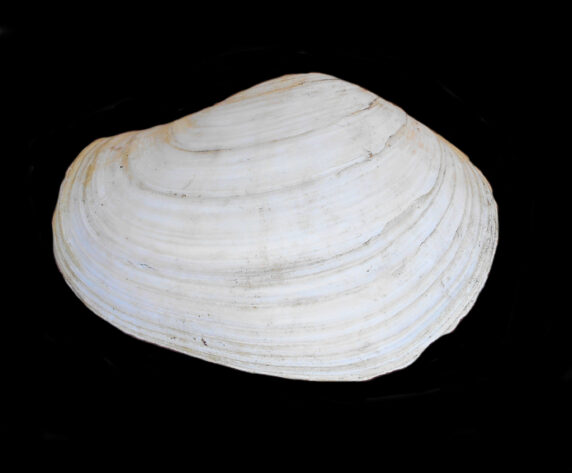 Cortez Geoduck Shell, Panopea globose
Cortez Geoduck Shell, Panopea globose
The Hiatellidae Family which are known commonly as Rock Borers and Giant Clams are bivalue mollusks that have shells, despite their common names, seldom boring into rock, nor are they all giant in size. Some species do bore into corals, rocks, mud, sponges and sand but most are “nestlers”, settling into a crevice as a larvae and then growing to fit the crevice. This produces an irregular shape, making identification of different species difficult. In general, the shells are oblong and in many species, the two valves are not equal in size and shape (inequivalve). For the majority the only portion of the shell where both valves touch one another is along the hinge affording a gaping separation between the valves. Otherwise, there is a gaping separation between the valves. The literal meaning of Hiatellidae is “Little Gaper”. The shells are sculpted with wavy concentric growth ridges.
Only a few species in the Hiatellidae Family are actually really large, with the animal always being much larger than the shell. The Pacific Geoduck, Panopea generosa, is the largest clam in North America whose shell reaches a maximum of 20.3 cm (8.0 inches) in length and the animal can be as long as 1 meter (39 inches). The longer species in the Hiatellidae Family burrow in soft substrates and are found from shallow water environments to depths up to 400 m (1,300 feet). Most of their body length is their siphon, allowing them to burrow up to one meter (3 feet) deep. These animals are suspension feeders, filtering plankton from the surrounding water, by use of their siphon. Most shells in the Family are whitish in color; many have a heavy periostracum.
Rock Borers and Giant Clams are found worldwide, in polar to tropical seas. They have a limited number of predators that include fish, marine mammals, and sea stars. The lack of predators may contribute to their long-life spans, as some species can live up to one hundred sixty-eight years. There are twenty-five species in the Family of which three are found in coastal waters along the coasts of the Baja.